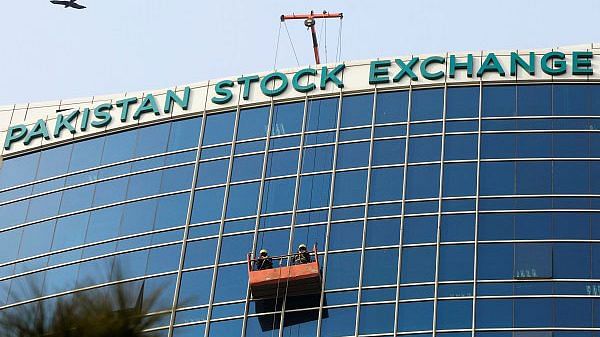New Delhi: Pakistan rang in the new year with a happy high after its stock market closed 2023 as the best performing globally and started 2024 on a rally of over 2,200 points Monday.
From hitting a three-year low of 38,136 points in January to a ‘historic high’ of 67,094 points in December, the benchmark KSE-100 index saw a remarkable turnaround in 2023 and also gained the title of the third best performing market in local currency.
According to Bloomberg data, the Pakistan Stock Exchange (PSX) emerged as the best-performing market in the second half of 2023, boasting a 51 per cent gain in rupee terms and a 54 per cent return in US dollars.
A number of factors, including a $3 billion IMF loan programme, stabilisation of the rupee-dollar exchange rate, and successful completion of the first IMF review, propelled the PSX’s benchmark KSE-100 index to a 14-year high with a staggering 55 per cent growth.
The surge on the first day of 2024 marked the index’s second-highest climb in a single day, reflecting the resilience and optimism that continue to define Pakistan’s stock market.
How IMF contributed to Pakistan’s stability
In 2023, Pakistan found itself grappling with an escalating risk of debt default, unprecedented inflation figures, record-high yields on government bills, and political instability—all of which set the stage for a challenging market landscape, leaving investors cautious and predominantly on the sidelines during the initial months.
Amid political instability and economic hardships, the PSX hit rock bottom at 38,136 points in January 2023. However, a resurgence began in the second half of the year when foreign investors, reassured by stability in the exchange rate, returned after a three-year hiatus. This renewed confidence resonated across the investor spectrum, driving the market’s phenomenal growth.
According to Business Recorder, the breakthrough arrived on 30 June, during the Eid ul Azha holidays, when Pakistan secured a last-minute agreement with the IMF. The agreement outlined policies supported by a substantial $3-billion, nine-month Stand-By Arrangement (SBA). Viewed as a significant positive for a country in crisis, this agreement not only extended Pakistan’s commitment to the IMF well into the second half of fiscal year 2023-24 but also surpassed earlier expectations of a $1.1 billion disbursement.
The IMF programme not only acted as a stabilising force but also served as a catalyst for renewed investor confidence, according to market analysts.
In August, a transition of power to the interim government under Prime Minister Anwaar-ul-Haq Kakar further alleviated uncertainties on the political front. The interim government, tasked with overseeing the country until fresh elections, implemented measures such as State Bank of Pakistan’s “structural reforms” for Exchange Companies and administrative actions against currency hoarding and illegal exchanges. These steps, coupled with a gas price hike addressing circular debt issues in the energy sector, contributed to the stabilisation of the rupee and increased investor confidence.
Continuous dialogue with the IMF and improvements in the rupee’s value propelled the PSX beyond the coveted 50,000 mark on 19 October, a milestone achieved after over six years. The momentum persisted, and the stock market continued to break new records, with foreign investors increasing their participation, indicating a growing optimism about the country’s economic recovery.
In November, Pakistan’s stock market experienced the highest monthly net inflow of foreign portfolio investment in four years. International corporations invested $66 million, resulting in a net buying of $35 million. Simultaneously, on 15 November, the IMF and Pakistani authorities reached an agreement on the first review of the $3-billion SBA, providing additional impetus to an already buoyant market.
The pinnacle of this resurgence was reached in December when the KSE-100 index soared to a historic high of 67,094 points, reflecting optimism over an anticipated reduction in the central bank’s key policy rate and attractively low share prices compared to their peaks. The bullish trend, however, faced a correction in the last week of December, with panic selling causing the market to witness its largest single-day drop of 2,534 points, or 4.11%.
According to market analysts, KSE may climb to 85-90k level by the end of 2024.






